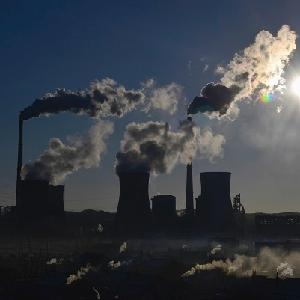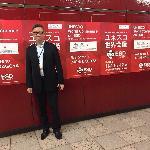
China’s (New)Clear Future by Generation of Change
Please find below the
Finalist Evaluation
Judges'' comments
Thank you for your innovative proposal. It is an interesting recommendation for study. Several other studies exist and would be complemented by this work.
Semi-Finalist Evaluation
Judges'' ratings
| • | Novelty: | |
| • | Feasibility: | |
| • | Impact: | |
| • | Presentation: |
Judges'' comments
Thank you for your creative proposal. For the next round of judging:
-expand on the barriers to expanding nuclear energy and other generating capacity that is more energy efficient.
-For such an initiative to have legs, such a report would have to be authored by the Chinese ministries responsible for implementing energy and other planning
-Experts on these issues exist today and have a voice at the table; how will these new experts differ?
 Kim Hor Toh Jun 15, 2016 10:53 | Proposal creator Barriers to China's (New)Clear Future: (Nuclear Energy and the "Other Generating Capacity" Category) There will be many barriers to nuclear energy (as well as the "Other Generating Capacity" Category) [OGC Category]. Although nuclear power is emissions free, it is still inefficient and dangerous. For example, a typical nuclear reactor only uses about 5% of its fuel. The introduction of new fourth generation technology like high-temperature gas-cooled pebble-bed reactors (HTGR), molten-salt reactors fueled by thorium, sodium-cooled fast reactors [to reduce the risk of a nuclear reactor meltdown] and travelling wave reactors (TWR) to reuse depleted uranium as its fuel etc. could ameliorate these problems. These fouth generation technology are now being introduced in China. Further research and development is still definitely required to improve China’s nuclear sector and the funding has be obtained by categorizing nuclear energy as a national strategic industry (with the aim of exporting this technological capability worldwide). Hopefully China will also study the feasibility of converting nuclear materials for military purposes to civilian use such as electrical power generation. Furthermore the depressed global commodity prices for crude oil, gas and coal (fossil fuels) will pose a cost competitive disadvantage for investing in nuclear energy. In July 2013 China’s National Development and Reform Commission (NDRC) set a wholesale power price of CNY 0.43 per kWh (7 US cents/kWh) for all new nuclear power projects, to promote the healthy development of nuclear power and guide investment into the sector. The price is to be kept relatively stable but will be adjusted with technology advances and market factors, though many consider it not high enough to be profitable. Therefore to make nuclear energy viable, China will need to depend on its highly regulated energy market to accelerate and scale up nuclear energy projects by providing subsidies to nuclear energy and the OGC Category. This support will enable nuclear energy (including the other OGC Category) to develop and become cost competitive (i.e. till there is an economy of scale). The 13th Five-Year Plan formalized in March 2016 included the following nuclear projects and aims:
This demonstrate the political will (at top level) as well as the financing budgeted to implement them. It is unprecedented for China to embark on such a massive and tight time frame endeavor for its nuclear energy sector. To set up an entire infrastructure/eco-system of this scale will be a major undertaking, from the viewpoint of project management. Therefore China truly needs the support and expertise of the international community if it is to pull this through successfully. |
 Kim Hor Toh Jun 15, 2016 11:05 | Proposal creator Collaboration with China Government Agencies (Providing Legs to the Proposal) It is essential that this proposal gets a China Government Agency to sponsor it, likely through a form of joint collaboration. To get both legs to walk for this report (by both leg, I mean the civilian use of fissile material for nuclear power plants and the military use of fissile material to produce nuclear weapons), obtaining a China government agency as a sponsor to this report and also as a collaborator will ensure internal buy-in by the China stakeholders on this subject-including the Military.I envisage the study report will be a collaboration with Chinese counterparts like the Energy Research Institute (ERI) of the National Development and Reform Commission (NDRC). The report will also need to include input from other China government entities like the China Institute of Atomic Energy (China's IAEA), China Nuclear Energy Association (the quasi-government association representing the nuclear power sector), the NDRC, Ministry of Energy, Ministry of Environment, Ministry of National Defense and other related stakeholders.Having such broad input will enable the Chinese policy makers from all related sectors to make improvements on this study report so as to ensure that China’s national economic and climate change strategies are comprehensively deliberated. I envisage forming a comprehensive fact based report of this nature will have to take into account the interest of all related parties (and if there's conflicting interest at stake, they should be discussed and solutions be made available which is amicably acceptable). This to me is a key point to enable this report to have legs. There already are many experts on the table (internationally and domestically) but to enable it to be successfully implemented on the ground, it will require a broad based buy-in from another "new experts" i.e. other interested parties who has a stake on this proposal at all levels. The fact that the strategic direction of nuclear energy and the "Other Generating Capacity" Category has been set in the 13th Five-Year Plan, and endorsed at the top level, however implementation is another matter all together in China. I hope the study report will also serve as a platform for civil society (Research Institutes, Academic Institutions, NGOs, NPOs etc.), which makes up a marginal voice in policy decision making in China- for them to participate in the debate to shape China’s nuclear power policy both economically and for its national defense. (Note: To involve the Military will require top level involvement/clearances. However there are avenues like the PLA's Academy of Military Science or other military related think tanks like the China Foundation for International and Strategic Studies who could assist to facilitate inputs/feedback.) |